A forex carry trade is borrowing a currency with a relatively low interest rate and using those funds to buy a currency with a higher interest rate. The goal is to earn the “interest rate differential” between the two currencies. While this can create a steady stream of potential income, it also carries the usual risks of currency fluctuations, so having a clear strategy and risk controls in place is essential.
A carry trade looks to capitalize on stable trends in currency pairs, where the higher-yielding currency is expected to maintain or even appreciate in value. We’ll explain the mechanics, the best currency pairs, and how interest rates influence carry trades.
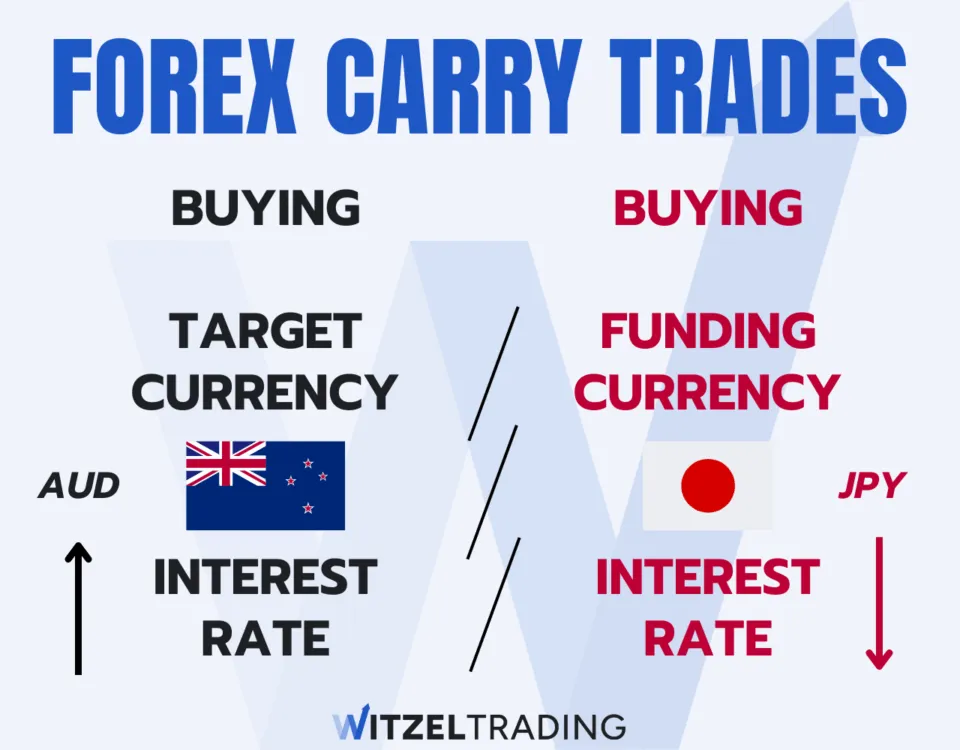
Key Facts About A Currency Carry Trade
- Stable or Gradual Trends Matter: Carry trades thrive in calm or steadily trending environments.
- Interest Rate Differential Is Key: Earning the daily swap depends on a noticeable gap between the rates of two currencies.
- Long-Term Approach: Many carry traders hold positions for extended periods, capturing multiple daily rollovers.
- Timing Around Economic Events: Interest rate announcements and major news releases can alter the viability of a carry strategy.
- Broker Rollover Policies Vary: Each broker has its own approach to swaps and overnight fees, which can influence your net gains.
Example Of A Forex Carry Trade
Let’s consider NZD/JPY with these hypothetical 2024 interest rates:
- New Zealand’s benchmark rate: 4.25%
- Japan’s benchmark rate: 0.50%
That sets an approximate rate gap of 3.75%. Here’s a simplified scenario:
- Borrow 1,000,000 JPY at 0.50% annually.
- Convert to NZD when the rate is 85 JPY = 1 NZD. Your million yen becomes about 11,764 NZD (1,000,000 ÷ 85 ≈ 11,764).
- Earn 4.25% on those NZD holdings, which is about 500 NZD per year.
After a year, you convert your interest of roughly 500 NZD back to JPY at the same exchange rate (assuming it doesn’t change). That equates to about 42,500 JPY. Subtracting the 5,000 JPY cost of borrowing the yen (1,000,000 JPY × 0.5%), your net interest gain is around 37,500 JPY. If NZD/JPY remains stable or moves in your favor, you keep that difference; however, a drop in the NZD’s value against the JPY could reduce or eliminate your profit.
How To Do A Currency Carry Trade
Successfully carrying out a forex carry trade involves more than just finding two currencies with an interest rate difference. Below is a more detailed process to help ensure you cover the necessary steps and manage your risk:
Step 1: Identify the Rate Gap and Market Conditions
Start by looking for a pair where one currency offers a higher rate, while the other is known for lower rates. Check if current market sentiment is relatively calm, as sudden volatility can create problems for a strategy that aims to collect interest over time.
Step 2: Assess Economic Indicators and Central Bank Policies
Review key data such as inflation reports, employment numbers, and GDP growth for both currencies. Central bank statements, for example from the Turkish central bank, and policy decisions can shift interest rates quickly. If you anticipate significant changes, it might affect the rate gap you’re planning to exploit.
Step 3: Choose a Suitable Broker
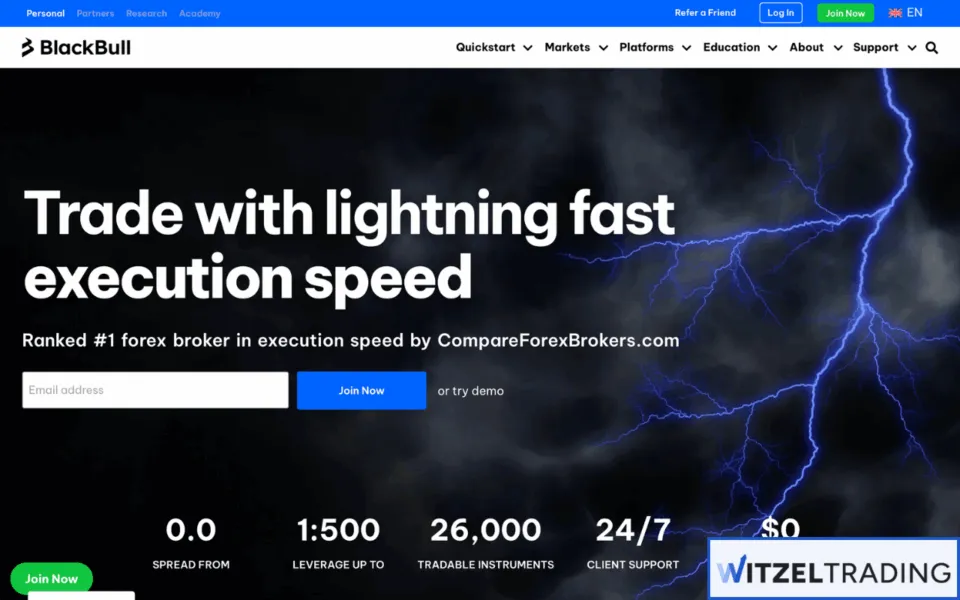
Prioritize brokers who publish transparent overnight swap rates and maintain reliable execution. We recommend BlackBull Markets for their trustworthiness in the industry. High spreads or hidden fees can negate much of the interest you’re hoping to earn. Also, confirm that the broker supports the specific pair you plan to trade.
Step 4: Calculate Potential Returns vs. Risk
Before trading, estimate the daily or weekly interest you could earn and compare it to how much the currency might move against you. A simple calculation of the interest rate difference won’t mean much if a sharp drop in the higher-rate currency undermines your gains. Use realistic scenarios, including stress tests, to see how the trade might perform under different market conditions.
Step 5: Establish Position Size and Leverage
Determine how large your position should be based on your account balance and personal risk tolerance. A smaller position might reduce potential returns, but it can also help you avoid large drawdowns if the market turns. Overextending yourself can lead to forced liquidations or major losses.
Step 6: Open the Position and Track Swaps
Go long on the currency with the higher interest rate and short the lower-rate currency. Monitor the broker’s daily swap charges or credits to confirm they match your expectations. Some brokers adjust their swaps on Wednesdays or around holidays, which can temporarily alter the rate you receive.
Step 7: Monitor Economic Events and Sentiment
Stay updated on financial news, monetary policy announcements, and global sentiment shifts. A favorable interest rate gap can quickly lose its appeal if central banks signal changes or if the market mood swings toward safer assets. Adjust your position size, tighten stop-loss levels, or exit entirely if the outlook changes drastically.
Step 8: Review and Adjust Periodically
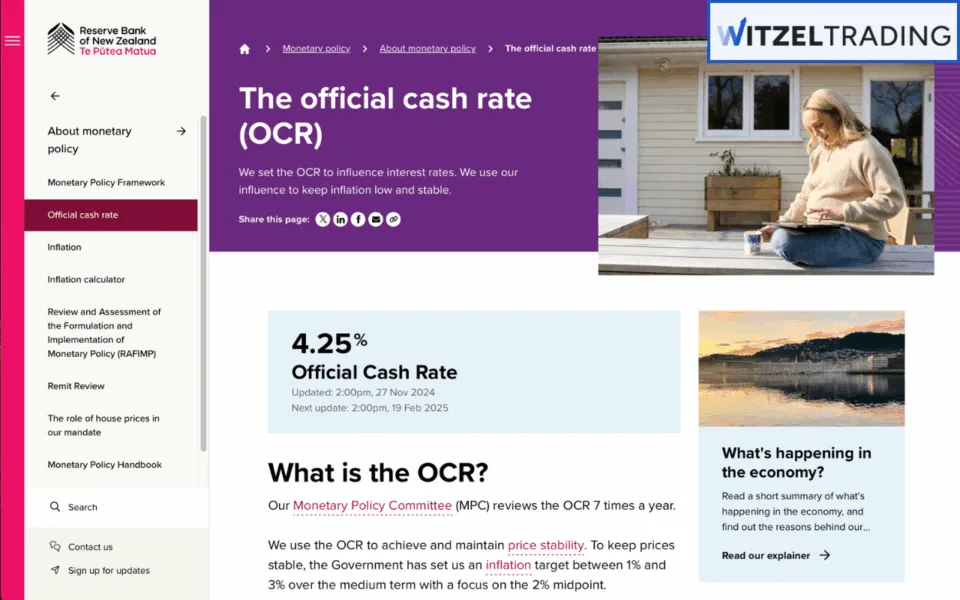
Carry trades are often held for weeks or months, but they’re not “set and forget.” If a central bank alters its stance or if market conditions change, you may need to reassess whether the trade is still worthwhile. Consistent reviews help you lock in gains or limit losses when the strategy’s core assumptions no longer hold.
What Are The Best Currency Pairs For Carry Trades?
While any pair with a clear central bank interest rate gap can be considered for a carry trade, some pairs are notably more popular. Here are a few that often come up, along with the forces shaping their behavior.
AUD/JPY

Australia usually sets higher rates than Japan, so AUD/JPY frequently provides a noticeable interest differential. Australian exports in the commodities sector can increase the AUD’s strength when global demand is solid, but any slowdown can weigh on the currency. Japan keeps its rates low to stimulate economic activity, making it a common funding currency for carry trades. Still, if global sentiment switches to a more cautious stance, the yen might appreciate as investors move to safer assets, cutting into your potential gains.
NZD/JPY
New Zealand’s economy also tends to support higher rates compared to Japan, creating another gap that appeals to carry traders. The NZD can be influenced by agricultural output and trade relationships, so factors like dairy prices or a shift in global risk appetite can shape its value. Japan, by contrast, rarely raises rates, aiming to combat long-standing economic challenges.
GBP/CHF
The British pound occasionally offers a moderate advantage over the Swiss franc. While the UK’s monetary stance can be more dynamic, the franc is often seen as a safe haven, especially in uncertain market conditions. This pairing works best if you believe the pound can hold steady or gain against the franc while you collect the daily interest.
However, political changes or economic surprises in the UK can cause rapid fluctuations that cancel out the yield.
USD/TRY
The Turkish lira generally has a higher benchmark rate than the US dollar, which can lead to large daily swap payments. Traders who pursue USD/TRY carry trades must pay close attention to Turkey’s inflation numbers and political developments, as these can cause significant currency swings. While the high yield can look tempting, sudden shifts in confidence about Turkey’s economy or monetary policy can quickly move the exchange rate. A protective stop-loss and regular monitoring of news events are essential for managing the risks here.
EUR/HUF
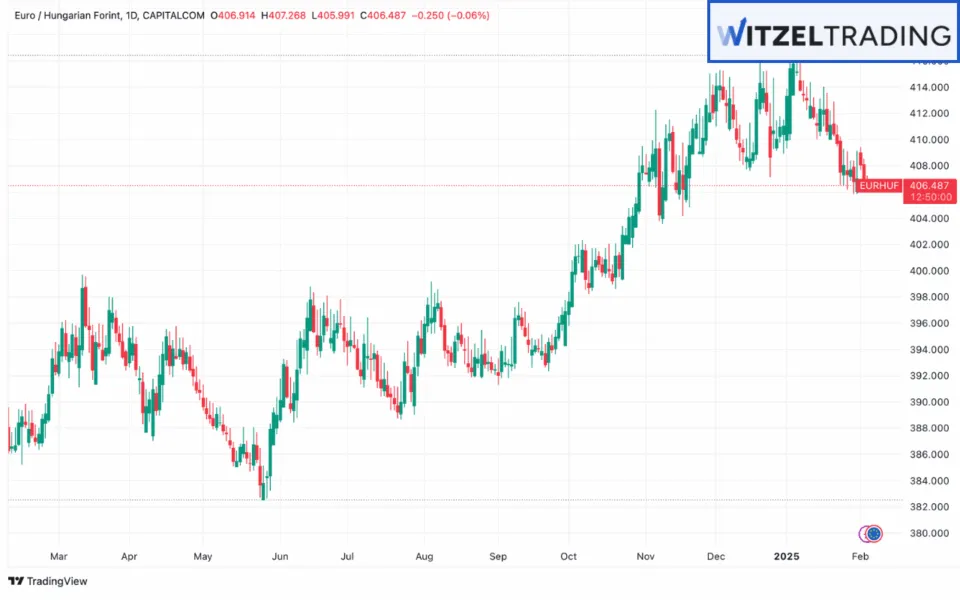
The euro (EUR) sometimes has a lower rate than the Hungarian forint (HUF), creating a potential gap worth exploring. Hungary has been known to adjust rates to manage inflation and currency stability, which can result in a noticeable difference compared to the euro’s more conservative policy path. If the European Central Bank keeps rates low while Hungary’s rates remain relatively elevated, a carry trade here could accumulate daily interest. However, shifts in European economic sentiment or changes in Hungary’s fiscal policies may alter the balance sooner than expected.
How Does The Interest Rate Influence Forex Carry Trades?
The difference between two currencies’ rates dictates how much daily interest you gain or lose on an open position. When the higher-rate currency experiences a rate hike, the potential swap payment might increase, strengthening your position – assuming the exchange rate doesn’t move against you.
However, if the lower-rate currency undergoes a rate increase, the gap narrows, reducing your net interest. Economic indicators such as inflation, employment, and GDP often guide central banks in making these decisions. For that reason, carry traders should keep a close eye on scheduled announcements and the broader economic environment.
How Much Money Can You Earn With FX Carry Trades And What Are The Limitations?
The amount you can earn depends largely on the size of your position, the interest rate gap, and how long the trade remains open. If you’re holding a meaningful lot size in a pair that has a steady daily interest payout, the recurring credits can add up. However, gains vary widely based on your broker’s swap policy, leverage usage, and how stable the currency pair is during your holding period.
Any sudden exchange rate drop can quickly wipe out days or weeks of accumulated interest, so there’s no fixed amount you’re guaranteed to make. Markets also react to central bank announcements and economic shifts, meaning the environment can change unexpectedly.
Because of these factors, it’s wise to keep a realistic outlook, manage your position sizes carefully, and regularly review economic data to decide whether to stay in or close out the trade.
Pros And Cons Of Forex Carry Trades
Pros
- Steady potential income via daily or weekly interest rollovers
- Long-term approach doesn’t require constant micromanagement
- Straightforward concept once you grasp interest rate differentials
- Possibility to earn double gains if the exchange rate moves favorably
- Offers diversification for traders who mainly focus on short-term moves
- Simple to set up once you choose a broker with clear swap policies
- You can hedge part of your carry trade if you see short-term volatility
- Accumulated swap payments can become substantial over time
- Helps you keep a broader view of macro trends and policy moves
- Often suits a stable or gradually trending market environment
Cons
- Sharp currency swings can erase multiple days’ worth of interest
- Central bank rate changes can drastically reduce your rate advantage
- Requires understanding of global economic events and indicators
- Volatile markets can quickly turn profitable trades into losses
- Some brokers charge additional swap markups that reduce net returns
- Major geopolitical events can lead to rapid “risk-off” market shifts
- Hedging reduces overall yield potential
- Not ideal for fast-paced traders seeking immediate returns
- Negative news from either currency’s region can disrupt the trade
- Requires consistent monitoring of policy statements to avoid unexpected price movements
Learn FX Trading With WR Trading
Carry trading can open the door to steady returns when the conditions are right, but it’s never a substitute for a well-rounded forex education. The WR Trading course specializes in building that broad understanding, covering everything from chart analysis and economic fundamentals to nuanced risk management approaches in forex trading. Rather than chasing short-term trends, you’ll learn how to recognize opportunities within the bigger picture of global markets.
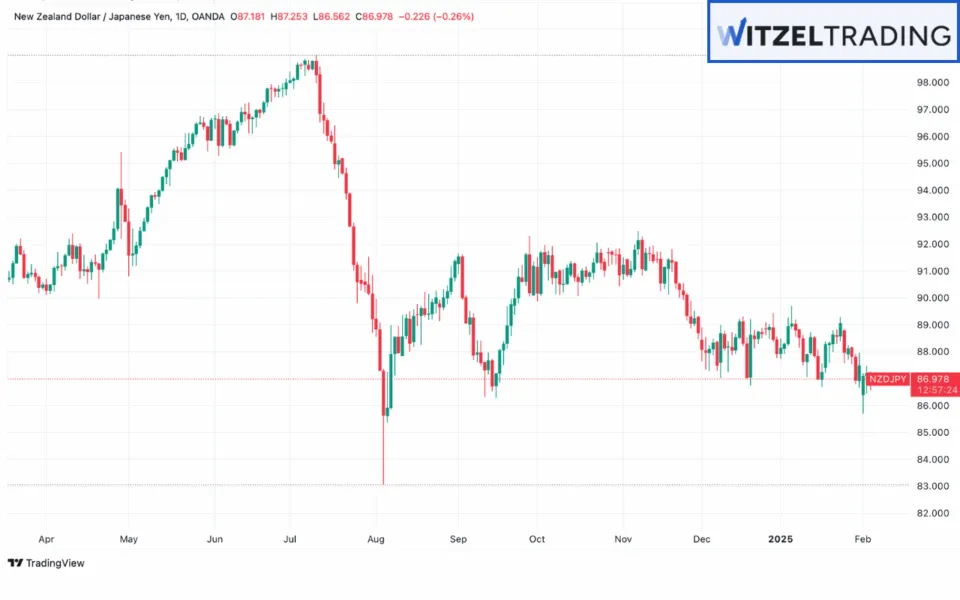
Our education at WR Trading blends hands-on tutorials with real-world market insights, ensuring that you have both the theory and practical skills to trade with confidence. If you’re aiming to refine a particular strategy or broaden your overall market perspective, our course offers resources and guidance to help you become a more capable forex trader.
Frequently Asked Questions on Forex Carry Trades
How Do I Know if a Carry Trade Is Right for Me?
Take a look at your preferred trading style and your comfort with holding positions for weeks or months. If you like the idea of collecting interest and can tolerate the risk of exchange-rate swings, it could be a good fit. Make sure you’re prepared to monitor market news and adjust quickly if conditions change.
Do I Earn Interest Every Day on a Carry Trade?
Most brokers apply “swap” or “rollover” credits or debits once per trading day. You’ll see it reflected in your account usually around the market’s daily close. Keep in mind that some brokers have different rules for weekends or holidays, so read their policy carefully.
Can I Lose More Money Than the Interest I’ve Earned?
Yes. If the currency pair moves sharply against you, any accrued interest can be wiped out quickly. This is more impactful if you’re using leverage, which magnifies both gains and losses.
Do Interest Rates Stay the Same Throughout My Trade?
Not necessarily. Central banks can adjust rates with little warning based on economic data, and those decisions directly affect your swap. Keep an eye on rate announcements and consider exiting if you sense a significant shift could be coming.
Does a Higher Interest Differential Always Mean More Profit?
A bigger gap can lead to higher daily interest credits, but it also often comes with more volatility. Emerging-market currencies with high rates can experience major swings, so the gains might be offset by price drops. Always weigh potential yield against known risks.


